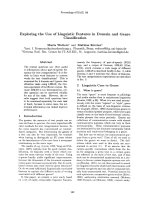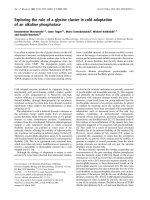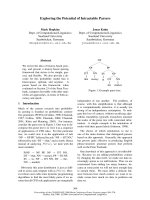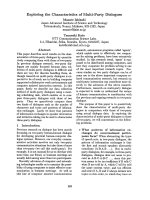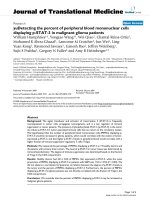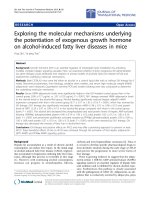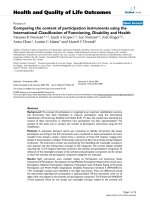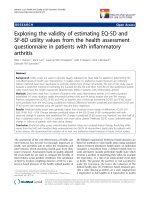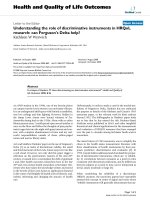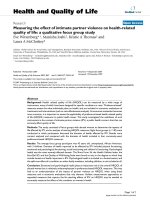Báo cáo hóa học: " Exploring the molecular mechanisms underlying the potentiation of exogenous growth hormone on alcohol-induced fatty liver diseases in mice" ppt
Bạn đang xem bản rút gọn của tài liệu. Xem và tải ngay bản đầy đủ của tài liệu tại đây (2.54 MB, 15 trang )
RESEARC H Open Access
Exploring the molecular mechanisms underlying
the potentiation of exogenous growth hormone
on alcohol-induced fatty liver diseases in mice
Ying Qin
*
, Ya-ping Tian
*
Abstract
Background: Growth hormone (GH) is an essential regulator of intrahepatic lipid metabolism by activating
multiple complex hepatic signaling cascades. Here, we examined whether chronic exogenous GH administration
(via gene therapy) could ameliorate liver steatosis in animal models of alcoholic fatty liver disease (AFLD) and
explored the underlying molecular mechanisms.
Methods: Male C57BL/6J mice were fed either an alcohol or a control liquid diet with or without GH therapy for 6
weeks. Biochemical parameters, liver histology, oxidative stress markers, and serum high molecular weight (HMW)
adiponectin were measured. Quantitative real-time PCR and western blotting were also conducted to determine
the underlying molecular mechanism.
Results: Serum HMW adiponectin levels were significantly higher in the GH1-treated control group than in the
control group (3.98 ± 0.71 μg/mL vs. 3.07 ± 0.55 μg/mL; P < 0.001). GH1 therapy reversed HMW adiponectin levels
to the normal levels in the alcohol-fed group. Alcohol feeding significantly reduced hepatic adipoR2 mRNA
expression compared with that in the control group (0.71 ± 0.17 vs. 1.03 ± 0.19; P < 0.001), which was reversed by
GH therapy. GH1 therapy also significantly increased the relative mRNA (1.98 ± 0.15 vs. 0.98 ± 0.15) and protein
levels of SIRT1 (2.18 ± 0.37 vs. 0.99 ± 0.17) in the alcohol-fed group compared with those in the control group
(both, P < 0.001). Th e alcohol diet decreased the phosphorylated and total protein levels of hepatic AMP-activated
kinase-a (AMPKa) (phos phorylated protein: 0.40 ± 0.14 vs. 1.00 ± 0.12; total protein: 0.32 ± 0.12 vs. 1.00 ± 0.14;
both, P < 0.001) and peroxisome proliferator activated receptor-a (PPARa) (phosphorylated protein: 0.30 ± 0.09 vs.
1.00 ± 0.09; total protein: 0.27 ± 0.10 vs. 1.00 ± 0.13; both, P < 0.001), which were restored by GH1 therapy. GH
therapy also decreased the severity of fatty liver in alcohol-fed mice.
Conclusions: GH therapy had positive effects on AFLD and may offer a promising approach to prevent or treat
AFLD. These beneficial effects of GH on AFLD were achieved through the activation of the hepatic adiponectin-
SIRT1-AMPK and PPARa-AMPK signaling systems.
Background
Hepatic fat accumulation as a result of chronic alcohol
consumption can induce liver injury. In the initial stage
of alcohol-induced fatty liver disease (AFLD), triglycer-
ides accumulate in hepatocytes inducing fatty liver (stea-
tosis), although t his process is reversible at this stage
[1]. However, with continuing alcohol consu mption,
steatosis can progress to steatohepatitis, fibrosis,
cirrhosis and even hepatocellular carcinoma [2]. Thus, it
is crucial to develop specific pharmacological drugs to
treat a lcoholic steatosis during the early stage of AFLD
and prevent the progression to more severe forms of
liver damage.
There is growing evidence to suggest that the adipo-
nectin-sirtuin 1 (SIRT1)-AMP-activated kinase (AMPK)
signaling system is an esse ntial regulator of hepat ic fatty
acid oxidation and is inhibi ted by chronic alcohol expo-
sure. Furthermore, this pathway is closely assoc iated
with the pathogenesis of AFLD [3]. Adiponectin, an adi-
pokine that is exclusively secreted by adipocytes, plays
* Correspondence: ;
Department of Clinical Biochemistry, Chinese People’s Liberation Army
General Hospital, 28 Fu-Xing Road, Beijing 100853, PR China
Qin and Tian Journal of Translational Medicine 2010, 8:120
/>© 2010 Qin and Tian; licensee BioMed Central Ltd. This is an Open Access artic le distributed under the terms of the Creative Commons
Attribution License (http://creative commons.org/licenses/by/2.0), which permits unrestricted use , distribution, and reproduction in
any medium, provided the original work is properly cited.
an important role in regulating systemic energy metabo-
lism and insulin sensitivity in vivo. Adipone ctin was also
reported to be effective in alleviating alcohol- and obe-
sity-induced hepatomegaly, steatosis and serum alanine
transaminase (ALT) abnormalities in mice [4]. SIRT1 is
a NAD
+
-dependent class III protein deacetylase that reg-
ulates lipid metabolism through deacetylation of modi-
fied lysine residues on histones and transcriptional
regulators [5-7]. AMPK is a heterotrimeric protein con-
sisting of one catalytic subunit (a) and two non-catalytic
subunits ( b and g). Activated AMPK can phosphorylate
its downstream substrates to act as a metabolic switch
to regulate glucose and lipid metabolism [8-10]. Further-
more, activation of the adiponectin-SITR1-AMPK path-
way increases the hepatic activities of peroxisome
proliferator activated receptor-g (PPARg) and PPARa
coactivator (PGC1), and decreases the activity of sterol
regulatory element binding protein 1 (SREBP-1) in sev-
eral animal models of AFLD [7,11-13]. PGC1 and
SREBP-1 are the key transcriptional regulators of genes
controlling lipogenesis and fatty acid oxidation [7,14-16].
Growth hormone (GH ) is a n important regulator of
intrahepatic lipid metabolism. Hepatic GH can interact
with its receptor (GHR) on the surface of target cells
and induces the association of GHR with Janus kinase
(JAK)-2 to initiate tyrosine phosphorylation of GHR and
JAK2. Ph osphorylation of GHR and JAK2 consequently
activates multiple signaling cascades by phosphor ylating
a series of downstream signaling mol ecules, including
p38 mitogen-activated protein kinase (p38-MAPK),
AMPK and PPARa [18-20]. The activated signa ling
molecules regulate the transcription of GH-responsive
genes in the liver. Inhibition of endogenous hepatic GH
signaling might perturb lipid metabolism and induce
liver steatosis [21]. Our previous study showed that exo-
genous GH can prevent non-alcoholic fatty liver disease
(NAFLD). Cross-talk among GH regulative signaling
pathways can inhibit lipid synthesis, reduce hepatic tri-
glyceride (TG) accumulation, enhance glucose metabo-
lism and inhibit gluconeogenesis in the liver, and can
thus reverse hepatic steatosis and fibrosis [20].
Here, we explored the effects and molecular mechan-
isms of GH on AFLD. Viral vectors can induce longer-
lasting e ffects than recombinant protein administration
and thus avoid the inconvenience of repetitive subcuta-
neous injections. Therefore, we used GH gene delivery
technology rather than recombinant GH injection in
this study. The coding sequence (cds) for the GH1 gene
(human GH [hGH]; GenBank accession number
NM_000515) was transferred in vivo by recombinant
adeno-associated viral vectors pseudotyped with viral
capsids from serotype 1 (rAAV2/1), as previously
described [22].
Methods
rAAV2/1 vector containing the GH1 gene
The method used to construct the rAAV2/1 vector con-
taining the GH1 gene is described in more detail else-
where [20,22]. In brief, GH1 was cloned from a PCR
product using 5’-CA
GAATTCGCCACCATGGCTA-
CAGGCTCCCGG- 3’ (sense primer) and 5’-
CTGC
GTCGACGAAGCCACAGCTGCCCTC-3’ (anti-
sense primer) (EcoRIandSalI restriction sites are indi-
cated in bold/underlined) from the template of a pUC19
plasmid DNA containing GH1 (Xinxiang Medical Univer-
sity, Xinxiang, Henan Province, China). The 677-bp GH1
DNAfragment(includingthe651-bpcds)wasdigested
with SalIandEcoRI and inserted into the SalIandEcoRI
sites of the pSNAV2.0 vector (AGTCGene Technology
Co. Ltd., Beijing, China). rAAV2/1 production and purifi-
cation were performed as previously described [23]. The
viral genome particle titer (1.0 × 10
12
v.g./mL) was deter-
mined by quantitative DNA dot-blots [24].
Animal study
Male C57BL/6J mice weighing 25.0 ± 2.0 g were
obtained from the Institute of Laboratory Animal
Sciences, Chinese Academy of Medical Sciences & Pek-
ing Union Medical College (Beijing, China) and housed
in stainless steel wire-bottomed cages with a 12-h light/
dark cycle. Animal experiments were performed in
accordance with the guidelines of the National Institutes
of Health (Bethesda , MD, USA) and the Chinese Peo-
ple’s Liberation Army General Hospital for the humane
treatment of laboratory animals.
Mice were fed a liquid diet and distributed into six
groups: control and GH1-treated control (control groups);
alcohol and GH1-treated alcohol (alcohol groups); pair-fed
I and pair-fed II (pair-fed groups). The diet was based on
the Lieber-DeCarli formulation, and contained 35% of cal-
ories from fat (corn oil), 12% from carbohydrate, 18% from
protein, and 35% from ethanol (alcohol groups) or isocalo-
ric maltose dextrin (control and pair fed groups). The etha-
nol concentration was gradually increased from 17% to
35% during the first week of feeding and then maintained
at the same concentration for another 5 weeks [25]. Food
intake was recorded daily in the control and alcohol
groups. The food intake in the pair-fed groups I and II was
matched to the respective alcohol-fed groups. One week
after alcohol administration, mice in the GH1-treated con-
trol and GH1-treated alcohol-fed groups were intrave-
nously injected with a single dose of 1.0 × 10
11
rAAV2/1-
CMV-GH1 viral particles into the tail vein. The survival
study was repeated on three occasions to determine the
survival rate (18 mice per group on each occasion for the
alcohol group and GH1-treated alcohol group; 6 mice per
group on each occasion for all of the other groups). The
Qin and Tian Journal of Translational Medicine 2010, 8:120
/>Page 2 of 15
survival rate in each group w as calculated as the number of
survivors/total number of animals in each group × 100%.
Six weeks later, six of the surv iving mice fro m each
group were weighed and then euthanized, at which time
blood, liver tissue, and adipose tissues were collected.
The perirenal and e pididymal fat pads were pooled
(visceral fat, VF) and weig hed using a precision electro-
nic balance (AV264; Ohaus, Pine Brook, NJ, USA) to
determine VF percentage (VF%) of total body weight
(VF weight/body weight × 100%). The hepatic index
(HI) was calculated as liver weight/body weight × 100%.
Hepatic histology and measurement of triglyceride
content
Fresh liver sections were fixe d in 4% paraformaldehyde,
dehydrated, embedded in paraffin, and sectioned. For-
malin-fixed, paraffin-embedded sections were cut (5 μm
thick) and mounted on glass slides. The sections were
deparaffinized in xylene and stained with hematoxylin
and eosin using standard tec hniques. Hepatic steatosis
was classified into four grades based on fat accumula-
tion using the method devised by Brunt et al [26].
Briefly, grade 0 indicates no fat in the liver, while grades
1 (light), 2 (mild) and 3 (severe) were defined as the pre-
sence of fat vacu oles in < 33%, 33-66% or > 66 % of
hepatocytes, respectively. The fat deposition pattern was
classified as macrovesicular, microvesicular, or mixe d.
Biopsies were examined by two investigators blind to
the treatment groups. The value was calculated to
determine the inter-observer agreement. Hepatic TG
levels were measured as previously described [27].
Mouse serum assays
Insulin-like growth factor 1 (IGF-1; ADL, Alexandria,
VA, USA), insulin (ADL) and tumo r necrosis factor-a
(TNFa; R&D Systems, Minneapolis, MN, USA) were
measured using enzyme-linked immunosorbent assay
kits. Serum ethanol levels (blood alcohol concentration,
BAC) achieved in the mice after chronic ethanol admin-
istration for 6 weeks were measured using a blood alco-
hol test kit (Abbott laboratories, Abbott Park, IL, USA).
Serum b-hydroxybutyrate (b-OHB) was measured using
a colorimetric method (Stanbio, Boerne, TX, USA).
Serum levels of glucose, alanine aminotransferase, TG
and t otal cholesterol (TC) were determined using stan-
dard methods. Insulin resistance (IR) was assessed using
the homeostasis model assessment of IR (HOMA-IR) as
blood glucose × blood insulin/22.5 [28,29].
Lipid peroxidation
Malondialdehyde (MDA) was quantified using the thio-
barbituric acid reaction, as previously described [30,31],
and measured using a thiobarbituric acid reactive sub-
stances assay (Cayman Chemical Co. Inc., Ann Arbor,
MI, USA). In brief, 25 mg of liver tissue was added to
250 μl of radioimmunoprecipitation assay buffer con-
taining protease inhibitors. The mixture was sonicated
for 15 s at 40 V over ice and centrifuged at 1600 ×g for
10 min at 4°C. The supernatant was used for analysis.
Real-time quantitative polymerase chain reaction (qRT-
PCR)
Total RNA was extracted from liver and adipose tissue
samples and isolated and purified with TRIzol reagent
(Invitrogen, Carlsbad, CA, USA) and a NucleoSpin® RNA
clean-up kit (Macherey-Nage l, Duren, Germany). Fifty
nanograms of total RNA were used in qPT-PCR reactions.
qRT-PCR amplification was conducted in a LightCycler
(Roche Diagnostics, Pleasanton, CA, USA) using a Light-
Cycler-FastStart DNA Master SYBR Green I Kit (SuperAr-
ray Bioscience, Frederick, MD, USA). The following qRT-
PCR primer sets were purchased from SuperArray
Bioscie nce: SIRT1 (PPM05054A), GPAT1 (PPM33295A) ,
FAS (PPM03816E), SCD1 (PPM05664E), ACCa
(PPM05109E), ME (PPM 05495A), MCAD (PPM25604A),
AOX (PPM04407A), CPT1a (PPM25930B), FOXO1
(PPM03381B), PGC1a (PPM03360E), adipoR1
(PPM35710A), adipoR2 (PPM 38032E), and PPARa (PPM
05108B). All samples and standards were amplified in tri-
plicate. Target mRNA was calculated using the compara-
tive cycle threshold (Ct) method by normalizing the target
mRNA Ct for that of GAPDH.
Western blotting and PGC1a acetylation assays
Liver nuclear protein or whole protein were extracted and
used for western blotting which was performed as pre-
viously described [20]. Total AMPKa, phospho-AMPKa
(p-AMPKa), phosph o-ACC (p-ACC) and PGC1a were
visualized using primary antibodies from Cell Signaling
Technology (Danvers, MA, USA). SIRT1 and SREBP-1c
were visualized using antibodies obtained from Santa Cruz
(Santa Cruz, CA, USA). Nonspecific proteins were used as
loading controls to normalize the signal obtained for liver
nuclear protein extracts. N-acetyl-leucinal-leucinal-nor-
leucinal (25 μg/mL) (Calbiochem, San Diego, CA, USA)
was present in all procedures for nuclear SREBP-1c
(nSREBP-1) analysis. Polyclonal rabbit anti-GAPDH anti-
body (Sigma-Aldrich Co., S t. Louis, MO, USA) was used
to normalize the signal obtained for total liver protein
extracts. The working dilution for antibodies ranged from
1:500 to 1:2,000. PGC1a levels and acetylation were
detected using s pecific antibodies for PGC1a and acetyl
lysine, respectively (Cell Signaling Technology) [12,13].
Statistical analyses
Western blots were quantified using Image-Pro Plus
software version 6.0 (Media Cybernetics Incorporated,
Silver Spring, MD, USA). Data are means ± standard
Qin and Tian Journal of Translational Medicine 2010, 8:120
/>Page 3 of 15
deviation. Statistical analyses were done using SPSS soft-
wareversion13.0(SPSSInc.,Chicago,IL,USA).Stu-
dent’s t-test, one way-ANOVA, Kruskal-Wallis o ne-way
ANOVA on ranks and two-way analysis of v ariance (fol-
lowed by post hoc protected least square difference
tests) was used for other statisti cal analysis. Values of P
< 0.05 were considered significant.
Results
Survival rate
Survival analysis showed that the mice in the alcohol-fed
group began to die at the first week of al cohol adminis-
tration, with a survival of 24.07 ± 3.21% after 6 weeks of
alcohol administrati on (Figure 1). Chronic alcohol
administration also decrea sed the activity of mice and
induced immobility and grouping, and the growth of
coarse hair. There are no obvious differences in survival
rate between the alcohol and GH1-treated alcohol
groups at the start of alcohol administration. However,
GH1 treatment significantly slowed the decrease in sur-
vival rate at 3 weeks after starting alcohol administration
(85.18 ± 3.21% vs. 77.78 ± 5.56%; P < 0.05). At the end
of the experiments, the survival rate was 66.96 ± 5.56%
in the GH1-treated group, about 2.8-fold higher than
that in the untreated alcohol group (P <0.001)(Figure
1). The reason for the delayed onset of GH effe cts on
alcohol feeding may be that significant transgene expres-
sion following rAAVs-mediated gene transfer is not
observed for 1-2 weeks, reaching a plateau by 4-6
weeks. The expression delay is primarily determined by
the uncoating efficacy of vector genomes [32]. Neverthe-
less, GH administration increased the survival rate and
improved the general health condition of the surviving
mice at the end of experiment (Figure 1). Very few
deaths occurred in the control, GH1-treated control,
and pair-fed I and II groups (Figure 1), and mice in
these groups remained healthy.
GH1 gene expression in AFLD mice
We observed the development of the typical histological
and biochemical features of liver steatosis in the AFLD
mice models after 6 weeks of alcohol exposure. GH1
gene expression can be sustained for at least 6 months
after a single injection of rAAV2/1-CMV-GH1, as we
have reported elsewhere [22]. The alcohol diet did n ot
cause marked changes in serum IGF-1 levels, which
were similar to those in the control group (384.53 ±
38.75 ng/mL vs. 393.95 ± 46.65 ng/mL, P >0.05).How-
ever, IGF-1 was slightly but not significantly higher in
the GH1-treated control (415.32 ± 39.9 7 ng/mL) and
GH1-treated alcohol-fed groups (4 00.55 ± 50.78 ng/mL)
compared with the control group (P >0.05,Table1).
The serum insulin level in the alcohol-fed group was
24.47 ± 1.92 μU/mL, which was similar to that in the
control group (24.90 ± 2.19 μU/mL; P >0.05).The
serum insulin levels in the GH1-treated control and
GH1-treated alcohol-fed groups were 25.89 ± 2.45 μU/
mL and 25.60 ± 2.43 μU/mL, respectively, which were
slightly, but not significantly higher than that in the
control group (P > 0.05). The changes in s erum glucose
levels showed similar trends to those of insulin. As a
result, although GH1 treatment did not significantly ele-
vate the serum levels of insulin and glucose, it did sig-
nificantly increase HOMA-IR in the GH1-treated
control group and GH1-treated alcohol group as com-
pared with the control group (7.85 ± 0.61 vs. 7.14 ±
0.56 and 7.71 ± 0.38 vs. 7.14 ± 0.56, respective ly; both P
< 0.05, Table 1).
Food intake, body composition and HI
GH1 administration had apparent effects on the appetite
of alcohol-fed mice. The alcohol-fed group showed a
slow and progressive reduction in mean food intake,
decreasing to 12.0 ± 0.9 mL/d/mouse on day 40, com-
pared with 14.1 ± 1.5 mL/d/mouse in the control group
(P < 0.01). Appetite was partly reversed by GH1 treat-
men t (13.0 ± 0.9 mL/d/mouse; P < 0.05 vs. the alcohol-
fed group). The mean food intake was slightly but not
significantly higher in the GH1-treated control group
than in the control group throughout the experiment
(Figure 2A).
The body weight in the control group was 26.47 ±
1.02 g at the end of the study but did not increase sig-
nificantly versus baseline, and tended to decrease in the
pair-fed II group (25.13 ± 1.17 g), but not significantly.
The body weight of the alcohol-fed and pair-fed I
groups were 23.95 ± 1.36 g and 24.55 ± 0.98 g,
Figure 1 Survival rates. The survival rate was 100% at baseline and
decreased to 24.07 ± 3.21% in the alcohol-fed group and 66.96 ±
5.56% in the GH1-treated alcohol-fed group after 6 weeks of
treatment. The survival rate was maintained at 100% in the other
groups. n = 18 mice per group for the alcohol and GH1-treated
alcohol groups; n = 6 mice per group for the other groups.
Qin and Tian Journal of Translational Medicine 2010, 8:120
/>Page 4 of 15
Table 1 Metabolic parameters
Control GH1-treated control Alcohol GH1-treated alcohol Pair-fed I Pair-fed II
BAC (mmol/l) - - 22.13 ± 2.28 16.20 ± 1.54
###
b-OHB (μmol/l) 88.5 ± 10.48
d
246.4 ± 41.2
a
122.7 ± 15.36
c
164.53 ± 19.80
b
94.87 ± 10.43
d
92.80 ± 11.98
d
TG (mmol/l) 1.24 ± 0.31 1.13 ± 0.13 1.54 ± 0.22* 1.16 ± 0.28 1.15 ± 0.25 1.17 ± 0.32
TC (mmol/l) 4.04 ± 0.48 3.95 ± 0.36 3.91 ± 0.47 3.99 ± 0.60 4.10 ± 0.35 4.08 ± 0.28
IGF-1 (ng/ml) 393.95 ± 46.65 415.32 ± 39.97 384.53 ± 38.75 400.55 ± 50.78 399.05 ± 34.67 387.37 ± 21.68
Insulin (μU/ml) 24.90 ± 2.19 25.89 ± 2.45 24.47 ± 1.92 25.60 ± 2.43 24.60 ± 1.88 24.76 ± 2.42
Glucose (mmol/l) 6.46 ± 0.36 6.85 ± 0.45 6.23 ± 0.25 6.79 ± 0.42 6.32 ± 0.43 6.28 ± 0.47
HOMA-IR 7.14 ± 0.56 7.85 ± 0.61*
##
6.78 ± 0.62 7.71 ± 0.38*
#
6.92 ± 0.92 6.88 ± 0.47
TNFa (pg/ml) 8.50 ± 2.03
#
7.95 ± 1.75
##
10.83 ± 2.07* 8.77 ± 1. 94
#
8.20 ± 1.77
#
8.80 ± 1.93
#
Hepatic MDA (μM) 3.39 ± 1.09 2.27 ± 0.67*
##
3.77 ± 1.03 2.87 ± 0.81 3.17 ± 0.92 3.05 ± 0.59
n = 6 mice per group. *P < 0.05 vs. the control group;
#
P <0.05,
##
P < 0.01 or
###
P < 0.001 vs. the alcohol group. HOMA-IR: homeostasis model assessment of
insulin resistance; MDA: malondialdehyde; b-OHB: b -hydroxybutyrate; TC: total cholesterol; TG: triglyceride; TNFa: tumor necrosis factor-a.
Figure 2 Food intake and body composition. (A) Daily food intake. (B) Body weight. (C) Hepatic index. (D) Visceral fat percentage. HI: hepatic
index. VF%: visceral fat percentage. Error bars represent standard deviations. n = 6 mice per group. *P < 0.05 or **P < 0.01 vs. the control group;
#
P < 0.05,
##
P < 0.01 or
###
P < 0.001 vs. the alcohol group.
Qin and Tian Journal of Translational Medicine 2010, 8:120
/>Page 5 of 15
respectivel y, and was significantly lower than that in the
control group (both, P < 0.01). GH administration
reversed the loss of body weight in the alcohol-fed
group (26.17 ± 1.30 g; P < 0.01 vs. the alcohol-fed
group). Body weight was higher in the GH1-treated con-
trol group (27.07 ± 1.26 g) than in the control group,
although this was not statistically significant (Figure 2B).
Both HI (2.85 ± 0.18% vs. 2.54 ± 0.19%, respectively; P <
0.01) and VF% (0.66 ± 0.08% vs. 0.54 ± 0.06%, respectively;
P < 0.01) were significantly h igher in the alcohol-fed
group than in the control group, despite decreases in
appetite and body weight in the alcohol-fed group com-
pared with the control group. The HI and VF% were both
reduced to control levels in the GH1-treated alcohol-fed
group (2.69 ± 0.20% and 0.55 ± 0. 08%, respectively; both,
P > 0.05 vs. the control group; P <0.05andP <0.01vs.
the alcohol-fed group). The decreases in food intake in the
pair-fed groups did not cause obvious changes in HI (pair-
fed I: 2.51 ± 0.13 g; pair-fed II: 2.53 ± 0.16; both, P > 0.05)
or VF% (0.57 ± 0.05% and 0.53 ± 0.03%, respectively; P >
0.05), compared with the control group. These results sug-
gest that exogenous GH improves body composition and
prevents hepatomegaly in alcohol-fed mice, and thus ame-
liorated AFLD (Figure 2C, D).
Liver steatosis in the AFLD mouse model
The histo logical classification of steatosis in each group
is summarized in Table 2. The inter-observer agreement
was 0.83. The mean steatosis grade wa s lower in the
GH1-treated alcohol-fed group (grade 1) than in the
untreated alcohol-fed group (grade 2), which indicated
that GH1 treatment prevented alcohol-induced accumu-
lation of lipid droplets in the liver. Hepatic histologic
and pathologic imaging revealed marked microvesicular
or macrovesicular steatosis around the periportal zone,
necrosis and infla mmat ion, along with enlarged hepato-
cytes in the alcohol-fed mice (Figure 3). Notably, GH
administration improved the steatosis condition in the
alcohol-fed mice as there was much less hepatic accu-
mulation of lipid droplets in these mice (Figure 3).
Furthermore, fat deposition in the GH group was mainly
microvesicular (Figure 3). Overall, hepatic steatosis was
much less severe in the GH1-treated alcohol-fed mice
than in the untreated alcohol-fed mice. Quantification
of the hepatic lipid content was consistent with the his-
tological findings. GH1 therapy alone did not affect the
hepatic TG and serum ALT levels. The hepatic TG and
serum ALT levels in the GH1-treated control group
were 13.58 ± 1.48 mg/g and 40.10 ± 7.72 U/L, as com-
pared with 13.23 ± 2.14 mg/g and 45.47 ± 7.96 U/L in
the control group. However, alcohol feeding significantly
increased hepatic TG and serum ALT levels to 25.17 ±
4.34 g and 73.85 ± 12.27 U/L, respectively, compared
with the control group (both, P <0.001;Figure3),and
these levels were restored to t he normal levels by GH1
therapy to 13.88 ± 2.04 mg/g and 48.93 ± 8.12 U/L,
respectively(both, P > 0.05 vs. the control group; both, P
< 0.001 vs. the alcohol group) (Figure 3) In addition, the
changes in serum TG and TNFa levels showed similar
trends to that for hepatic TG and serum ALT (Table 1).
By contrast, serum TC levels did not change markedly.
Serum TC content was 4.04 ± 0.48 mmol/L in the con-
trol group, 3.95 ± 0.36 mmol/L in the GH1-treated con-
trol group, 3.91 ± 0.47 mmol/L in the alcohol group,
and 3.99 ± 0.60 mmol/L in the GH1-treated alcohol
group. Collectively, these results indic ate that GH1 ther-
apy seems to protect against further development of
alcoholic liver steatosis in mice.
Oxidative stress in the liver of AFLD mice
The hepatic MDA content (a lipid peroxidation product)
was 3.39 ± 1.09 μM in the control group. Chronic alco-
hol administration induced modest oxidative stress
although this was not significant, as evidenced by an
increased hepatic MDA level (3.77 ± 1.03 μM; P >0.05
vs. the control group) in the alcohol group. GH1 effec-
tively reduced th e hepatic MDA level in the co ntrol diet
mice (2.27 ± 0.67 μM; P < 0.05 vs. the control group)
and reduced the hepatic MDA levels in alcohol-fed mice
to normal levels (2.87 ± 0.81 μM, P > 0.05 vs. both the
control and alcohol-fed groups). T he MDA levels in th e
pair-fed I and II groups were 3.17 ± 0.92 μM and 3.05 ±
0.59 μM, respectively, similar to that in the control
group (Table 1).
Exogenous GH upregulated adiponectin and increased
hepatic adipoR2 expression in AFLD mice
Adiponectin plays a vi tal role in the prevention of alcoholic
liver steatosis. Previous studies showed that GH regulates
the expression of adi ponectin and its receptors in adipo-
cytes via the JAK2 and p38 MAPK pathways [4]. In our
study, alcohol feeding lowered the serum HMW adiponec-
tin levels in the alcohol group to 2.68 ± 0.62 μg/mL,
although not significantly, compared with 3.07 ± 0.55 μg/
mL in the control group (P > 0.05). GH1 therapy induced
remarkable increases in serum HMW adiponectin
Table 2 Grading of hepatic steatosis.
Group Steatosis grades
0123
Control 6 (6) 0 (0) 0 (0) 0 (0)
GH1-treated control 6 (6) 0 (0) 0 (0) 0 (0)
Alcohol 0 (0) 3 (2) 2 (2) 1(2)
GH1-treated alcohol 0 (0) 6 (5) 0 (1) 0 (0)
Pair-fed I 6 (6) 0 (0) 0 (0) 0 (0)
Pair-fed II 6 (6) 0 (0) 0 (0) 0 (0)
n = 6 mice per group. value = 0.8 3, SE (
k
) = 0.083, P < 0.01
Qin and Tian Journal of Translational Medicine 2010, 8:120
/>Page 6 of 15
concentrations in the cont rol-fed group (3.98 ± 0.71 μg/
mL; P < 0.001 vs. the control group), and reversed the
HMW adiponectin level to normal levels in the alcohol-fed
group (3.28 ± 0.49 μg/mL, P >0.05vs.thecontroland
alcohol-fed groups) (Figure 4A). Alcohol feeding signifi-
cantly reduced relative hepatic adipoR2 mRNA expression
than that in the control group (0.71 ± 0.17 vs. 1.03 ± 0.19,
respectively; P < 0.001), but did not inhibit hepatic adipo-
nectin recep tor 1 (a dipoR1) mRNA expression (0.92 ± 0.23
vs. 1.00 ± 0.21, respectively; P > 0.05) (Figure 4B, C). GH1
therapy in the control diet group increased adipoR2
mRNA levels , although n ot significantly ( Figure 4C). More-
over, GH1 therapy r eversed the e ffect of alcohol feeding on
adipoR2 b y increasing t he mRNA expression of adipoR2 to
normal levels (1.07 ± 0.16; P > 0 .05 vs. the control group; P
< 0.001 vs. the alcohol-fed group,) (Figure 4B, C).
We also determined the mRNA expression of adiponec-
tin, TNFa, SIRT1 and forkhead box transcription factor O
1 (FOXO1) in adipose tissues because adiponectin is
expressed and secreted by adipose tissue. Figure 4D shows
the relative expression levels of adiponectin and its possi-
ble regulators in adipose tissue. Alcohol feeding increased
the relative TNFa mRNA expression compared with that
in the control group (2.40 ± 0.75, P < 0.001 vs. the control
group). Although alcohol feeding did not affect the mRNA
expression of SIRT1 or FOXO1, GH1 therapy in alcohol-
fed mice significantly increased the relative expression of
SIRT1 (1.70 ± 0.48 vs. 1.00 ± 0.67, respectively; P < 0.001)
and FOXO1 (1.76 ± 0.24 vs. 0.98 ± 0.15, respectively; P <
0.001), as compared with the control group. GH adminis-
tration also suppressed TNFa expression and upregulated
adiponectin gene expression to normal levels (the GH1-
treated alcohol group vs. the alcohol group: TNFa, 1.00 ±
0.14 vs. 2.4 ± 0.75; adiponectin, 1.02 ± 0.18 vs. 0.70 ± 0.15;
both, P < 0.001) (Figure 4D).
Exogenous GH1 therapy stimulated hepatic AMPK and
PPARa activity in AFLD mice
Alcohol feeding significantly decreased the relative
phosphorylated levels of hepatic AMPKa (0.40 ± 0.14
Figure 3 Liver h istology. Accumulation of lipid droplets is evident in the liver of alcohol-fed mice, while relatively few lipid droplets were
found in the hepatocytes of other groups (hematoxylin/eosin staining; original magnification, × 40). Serum ALT levels show similar trends to
hepatic TG content in all groups. GH1 therapy reversed the alcohol-diet-induced increases in hepatic TG and serum ALT. ALT: alanine
transaminase; TG: triglyceride. n = 6 mice per group. Means without a common letter differ at P < 0.05 vs. the control group.
Qin and Tian Journal of Translational Medicine 2010, 8:120
/>Page 7 of 15
vs. 1.00 ± 0.12, respectively; P <0.001)andPPARa
(0.30 ± 0.09 vs. 1.00 ± 0.09, respectively; P < 0.001)
compared with that in the control group, with a simul-
taneous decrease in the total protein levels of AMPKa
(0.32 ± 0.12 vs. 1.00 ± 0.14, respectively; P < 0.001)
and PPARa (0.27 ± 0.10 vs. 1.00 ± 0.13, respectively; P
< 0.001) relative to the control group (Figure 5). Exo-
genous GH1 therapy restored the phosphorylated and
total protein levels of AMPKa and PPARa in the livers
of alcohol-fed mice (P < 0.001 vs. the alcohol-fed
group; P > 0.05 vs. the c ontrol group) and therefore
activated hepatic AMPK and PPARa in AFLD mice
(Figure 5).
GH1-mediated activation of AMPK was accompanied by
increased phosphorylation of acetyl-CoA carboxylase
(ACC), a downstream target of AMPK, in the GH1-treated
control (1.42 ± 0.25; P < 0.001 vs. the control group) and
GH1-treated alcohol-fed (1.30 ± 0.09; P <0.001vs.the
control group) groups (Figure 5). Its expression was sup-
pressed in the alcohol-fed group (0.48 ± 0.15; P < 0.001 vs.
the control group) and was restored by GH1-therapy in
the GH1-treated alcohol group (P <0.001vs.boththe
control and alcohol-fed groups). The relative protein
expression of hepatic microsomal cytochrome P450, family
4, subfamily A, polypeptide 1 (Cyp4A1) was significantly
increased by GH1 therapy in the control (1.18 ± 0.50 vs.
Figure 4 GH1 therapy upregulated adiponectin and enhanced hepatic adipoR2 mRNA expression in alcohol-fed mice. (A) Serum HMW
adiponectin concentrations. (B) Relative mRNA levels of adipoR1. (C) Relative mRNA levels of adipoR2. (D) Relative adipose tissue mRNA levels of
adiponectin, TNFa, SIRT1 and FOXO1. AdipoR1: adiponectin receptor 1; AdipoR2: adiponectin receptor 2; FOXO1: forkhead transcription factor O
1; HMW adiponectin: high molecular weight adiponectin; SIRT1, sirtuin 1; TNFa, tumor necrosis factor-a. n = 6 mice per group. Means without a
common letter differ at P < 0.05 vs. control group.
Qin and Tian Journal of Translational Medicine 2010, 8:120
/>Page 8 of 15
1.00 ± 0.13; P < 0.001) and al cohol-fed (1 .27 ± 0.15 vs. 1.00
± 0.13; P < 0.05) groups, as compared with the control
group (Figure 5). Its expression was also suppressed by the
alcohol-diet, showing similar trends to those of ACC.
Cyp4A1, a downstream target of PPARa, was assessed as a
marker of PPARa activation in vivo [33]. These results
indicate that exogenous GH1 therapy restores hepatic
AMPK and PPARa activities, which were suppre ssed by
alcohol feeding in mice.
Exogenous GH1 therapy upregulated hepatic SIRT1
expression in AFLD mice
Alcohol feeding reduced the relative mRNA (0.58 ± 0.15
vs. 0.98 ± 0.15; P < 0.05) and protein levels of hepatic
SIRT1 (0.33 ± 0.12 vs. 0.99 ± 0.17; P < 0.01) compared
with those in the control group. GH1 therapy signifi-
cantly increased the relative mRNA (1.98 ± 0.15 vs. 0.98
± 0.15; P < 0.001) and protein levels of SIRT1 (2.18 ±
0.37 vs. 0.99 ± 0.17; P < 0.001) in the alcohol-fed mice
compared with the control group and the alcohol-fed
group (Figure 6A, B). PPARg, which may be regulated
by SIRT1, is thought to be involved in the development
of alcoholic and nonalcoholic fatty liver [14-16]. We
found that chronic alcohol fee ding increased the relative
mRNA levels of PPARg, as compared with that in the
control group (1.47 ± 0.37 vs. 1.02 ± 0.04, respectively;
P < 0.001) and this was reversed in the GH1-treated
alcohol group (0.95 ± 0.15; P > 0.05 vs. the control
group; P < 0.001 vs. the alcohol-fed group).
PGC1a is a marker of SIRT1 and AMPK levels and
activities [7]. In the present study, alcohol feeding signif-
icantly reduced the relative PGC1a mRNA levels (0.58 ±
0.19 vs. 1.02 ± 0.08; P < 0.001) and significantly
increased PGC1a acetylation (1.42 ± 0.12 vs. 1.00 ±
Figure 5 GH1 therapy stimulated hepatic AMPK activit y in alcohol-fed mice. Western blottin g of liver extracts was performed using anti-
phosphorylated-AMP-activated protein kinase (AMPK)-a (anti-p-AMPKa), anti-AMPKa, anti-p- peroxisome proliferator activated receptor-a
(PPARa), anti-PPAR-a, anti-phosphorylated acetyl CoA carboxylase (p-ACC) and anti-microsomal cytochrome P450, family 4, subfamily a,
polypeptide 1 (Cyp4A1) antibodies. C: control group; GC: GH1-treated control group; A: alcohol group; GA: GH1-treated alcohol group; PI: pair-fed
group I; PII: pair-fed group II. n = 6 mice per group. Means without a common letter differ at P < 0.05 vs. the control group.
Qin and Tian Journal of Translational Medicine 2010, 8:120
/>Page 9 of 15
Figure 6 GH administration upregulated hepatic SIRT1 expression in alcohol-fed mice. (A) Hepatic mRNA expression of SIRT1. (B) SIRT1
protein levels. (C) Relative PGC1a acetylation. Hepatic nuclear SIRT1 protein levels were determined using an anti-SIRT1 antibody. A nonspecific
nuclear protein band was used to confirm equal loading and to normalize the data. PGC1a was immunoprecipitated from liver extracts and
immunoblotted with either an anti-acetylated lysine (Ac-Lys) antibody to determine the extent of PGC1a acetylation or with an anti-PGC1a
antibody to determine the total amount of PGC1a. C: control group; GC: GH1-treated control group; A: alcohol group; GA: GH1-treated alcohol
group; PI: pair-fed group I; PII: pair-fed group II. AOX: acyl-CoA oxidase; CPT1a: carnitine palmitoyltransferase 1a; MCDA: medium chain acyl-Co-A
dehydrogenase; PGC1a: PPARa coactivator; PPARg: peroxisome proliferator activated receptor-g; SIRT1: sirtuin 1. n = 6 mice per group. Means
without a common letter differ at P < 0.05.
Qin and Tian Journal of Translational Medicine 2010, 8:120
/>Page 10 of 15
0.14; P < 0.001) compared with those in the control
group (Figure 6C). GH1 treatment increased the relative
mRNA expression of PGC1a (GH1-treated control
group: 1.35 ± 0.19; GH1-treated alcohol: 1.25 ± 0.11;
both, P < 0.001 vs. the control group; both, P <0.001
vs. the alcohol-fed group) and decreased the extent of
PGC1a acetylation (0.50 ± 0.14 and 0.58 ± 0.16, respec-
tively; both, P < 0.001 vs. the control group; both, P <
0.001 v s. the alcohol-fed group). This suggests that the
effects of GH1 administration are mediated by hepatic
SIRT1 in AFLD mice (Fig ure 6A-C). In addition, GH1
therapy reversed the suppressive effects of alcohol on
the gene expression of PGC1a-regulated fatty acid oxi-
dation enzymes such as acyl-CoA oxidase (AOX), carni-
tine palmitoyltransferase 1a ( CPT1a) and medium chain
acyl-Co-A dehydrogenase (MCDA) (Figure 6A).
GH administration significantly reduced the BAC level
in the GH1-treated alcohol group as compared with the
Figure 7 GH1 therapy suppressed SREBP-1c activity and reduced the mRNA levels of SREBP-1-regulated genes encoding lipogenic
enzymes in the livers of alcohol-fed mice. (A) Nuclear SREBP-1c protein levels. (B) Relative mRNA levels of hepatic SREBP-regulated lipogenic
enzymes. A nonspecific nuclear protein band in nuclear extracts was used to confirm equal loading and to normalize the data. C: control group;
GC: GH1-treated control group; A: alcohol group; GA: GH1-treated alcohol group; PI: pair-fed group I; PII: pair-fed group II. ACCa: acetyl-CoA
carboxylase-a; FAS: fatty acid synthase; GPAT1: glycerol-3-phosphate acyltransferase; ME: malic enzyme; nSREBP-1: nuclear sterol regulatory
element binding protein 1; SCD1: stearoyl coenzyme A desaturase 1; SREBP-1, sterol regulatory element binding protein 1. n = 6 mice per group.
Means without a common letter differ at P < 0.05.
Qin and Tian Journal of Translational Medicine 2010, 8:120
/>Page 11 of 15
alcohol-fed group (16.20 ± 1.54 mmol/l vs. 22.13 ± 2.28
mmol/l; P < 0.001). BAC was not detected in the other
groups of mice (Table 1). Al cohol feeding modestly, but
significantly increased the serum b-OHB levels versus
that in the control group (122.70 ± 15.36 μmo l/L vs.
88.50 ± 10.48 μmo l/L; P < 0.01), which suggests that
some of the hepatic free fatty acids in alcohol-fed mice
might be converted to ketone bodies (Table 1). GH1
therapy dra matically increased the serum b-OHB levels
in the control-fed (246.40 ± 41.2 μmol/L) and in the
alcohol-fed groups (164.53 ± 19.80 μmol/L), as com-
pared with that in the control or the alcohol-fed mice
(all, P < 0.001). This suggests that GH administration
upregulates hepatic fatty acid oxidation, promotes the
generation of ketone bod ies, and prevents alcohol-
induced liver steatosis.
Hepatic activity of the lipogenic transcription factor
nSREBP-1c in alcohol-fed mice
SREBP-1c is regulated by SIRT1 as well as by AMPK
[11-13]. In the present study, the relative protein
expression of nSREBP-1c was significantly increased by
chronic alcohol feeding, as compared with that in the
control group (1.48 ± 0.21 vs. 0.96 ± 0.16; P < 0.001).
GH1 therapy dramatically reduced hepatic nSREBP-1c
protein expression in alcohol-fed mice to the normal
levels (0.88 ± 0.15; P > 0.05 vs. the control group; P <
0.001 vs. the alcohol-fed group). However, the levels of
nSREBP-1c in t he GH1-treated control group were
almost unchanged compared with those in the control
group (0.90 ± 0.09; P > 0.05 vs. the control group)
(Figure 7A). Chronic alcohol feeding increased the
relative mRNA expression of several SREBP-1c-regu-
lated lipogenic enzymes, including mitochondrial gly-
cerol-3-phosphate acyltransferase (GPAT1) (1.55 ±
0.19 vs. 1.00 ± 0.14; P < 0.001), stearoyl coenzyme A
desaturase 1 (SCD1) (1.52 ± 0.20 vs. 1.02 ± 0.15; P <
0.001), malic enzyme (ME) (1.65 ± 0.15 vs. 1.00 ± 0.14;
P < 0.001), fatty acid synthase (FAS) (1.50 ± 0.14 vs.
1.03 ± 0.14; P < 0.001) and ACCa (1.72 ± 1.15 vs. 1.00
± 0.18; P <0.001)ascomparedwiththatinthecontrol
group (Figure 7B). GH1 therapy in the control diet-fed
mice decreased the relative mRNA levels of these
enzymes (GPAT1: 0.45 ± 0.10, P < 0.001; SCD1: 0.58 ±
0.13, P < 0.001; ME: 0 .80 ± 0.06, P > 0.05; FAS: 0. 57 ±
0.10, P <0.001;ACCa: 0.76 ± 0.10, P >0.05)relative
to the control group, and induced equal or even
greater decreases in the alcohol-fed group (GPAT1:
0.33 ± 0.10, P < 0.001; SCD1: 0.40 ± 0.18, P <0.001;
ME: 0.90 ± 0.11, P > 0.05; FAS: 0.45 ± 0.15, P <0.001;
ACCa : 0.87 ± 0.05, P > 0.05). These findings suggest
that GH inhibits hepatic SREBP-1c act ivity in AFLD
mice.
Discussion
In this study, we examined whether chronic exogenous
GH administration (via gene therapy) could improve
alcoholic liver steatosis in mice, and we explored the
underlying mechanis ms. The animal model of AFLD
was successfully established using a previously described
method [7,25]. Chronic GH1 gene expression in vivo
was achieved by a single injection of rAAV2/1-CMV-
GH1, as we have de scribed previously [20,22]. As would
be expected, serum IGF-1 was also increased by GH1
therapy. We found that GH had positive effects in the
AFLD mice by improving body composition, ameliorat-
ing serum lipid profiles, suppressing hepatocyte lipid
droplet accumulation and decreasing oxidative stress.
GH is an essential regulator of intrahepatic lipid meta-
bolism and can regulate many important signaling mole-
cules to coordinate multiple lipid metabolism signaling
pathways [4,22,34,35]. For example, GH can activate
AMPK and PPARa in NAFLD rats [36,37]. Our recent
study showed that GH administration has preventive
effects against hepatic steatosis and fatty liver by regu-
lating downstream genes through the phosphorylation
or dephosphorylation of a group of signal transducers
and activators in several hepatic signal transduction
pathways [22].
Adiponectin can effectively alleviate hepatic steatosis
in both AFLD and NAFLD [4,20]. It is rather interesting
that GH can regulate adipocyte adiponectin and adipoR2
expression via the JAK2 and p38 MAPK pathways, and
raise serum HMW adiponectin, the most active adipo-
nectin isoform in the regulation of insulin and blood
glucose levels [4,38]. Furthermore, GH regulates p85
expression and phosphoinositide-3-kinase activity in
white adipose tissue while excess GH can induce insulin
resistance. Upregulation of adipocyte adiponectin and
adipoR2 by exogenous GH sensitizes adipocytes to the
effects of adiponectin on insulin sensitivity by activating
AMPK to stimulate glucose utilization and fatty acid
oxidation. These activities may partially compensate and
overcome exogenous GH-induced insulin resistance in
vivo [39-42].
It is generally accepted that the adiponectin-SIRT1-
AMPK signaling system plays a vital role in the develop-
ment of AFLD [3]. Here, we showed that chronic exo-
genous GH therapy upregulated adiponectin and SIRT1
expression, and stimulated AMPK activity in the livers
of chronically alcohol-fed mice. GH-mediated activation
of the adiponectin-SIRT1-AMPK system was accompa-
nied by increased circulating HMW adiponectin levels
and enhanced hepatic adipoR2 mRNA expression.
HMW adiponectin is the major bioactive isoform of adi-
ponectin, and is responsible for the insulin-sensitizing
effects of adiponectin, while adipoR2 is the predominant
Qin and Tian Journal of Translational Medicine 2010, 8:120
/>Page 12 of 15
adiponectin receptor in the liver [36]. Since SIRT1 can
positively regulate FOXO1 activity [37,43], the hepatic
SIRT1-FOXO1 axis may also be involved in adipoR2
mRNA upregulation. Moreover, recent studies have
shown that activated SIRT1 could act upstream of
AMPK by modulating LKB1– an upstream AMPK
kinase–which may serve as a key component in the
lipid-lowering e ffect in hepatic cells and in the liver in
vivo [7,44]. Hence, we deduced that the protective
effects of exogenous GH a gainst alcohol-induced liver
steatosis may be realized, at least in part, by turning on
the hepatic adiponectin-SIRT1-AMPK signal ing system
and related signaling pathways to ameliorate alcohol-
induced impairments in the signaling pathways contr ol-
ling lipid metabolism.
Furthermore, GH therapy increased PGC1a activity
and restored the mRNA levels of several PGC1a target
genes encod ing fatty acid oxidation enzymes in chronic
alcohol-fed mice. We also found that GH therapy
reduced hepatic SREBP-1c prote in levels and decreased
the mRNA expression of SREBP-1c target genes encod-
ing lipogenic enzymes in alcohol-fed mice. These find-
ings also indicate that GH administration coordinates
the adiponectin-S IRT1-AMPK signaling system to mod-
ulate its downstream signaling molecul es that regulate
the transcription of alcohol-responsive genes. These
pathways ultimately upregulated fatty acid oxidation,
reduced lipid synthesis, and prevented hepatic lipid
accumulation in alcohol-fed mice.
The hepatic targets of GH include the JAK2/STAT3
(STAT5), p38 MAPK, AMPK, ERK1/2 a nd PPARa sig-
naling pathways. We recently reported that GH adminis-
tration can activate AMPK-PPARa signaling [25].
PPARa is centrally involved in the regulation of lipid
homeostasis and is essential for normal liver function.
PPARa mainly participates in fatty acid b-oxidation and
plays an important role in modulating hepatic TG accu-
mulation. Inhibition of PPARa signaling may impair
lipoprotein transport, reduce fatty acid oxidation and
enhance lipogenesis, which ultimately induces the devel-
opment of steatosis [35,45]. In this study, we found that,
alcohol downregulated hepatic expression of PPARa
and CYP4A1, a typical downstream target of PPARa.
Meanwhile chronic exoge nous GH restor ed PPARa and
CYP4A1 expression, which probably contributed to the
improvements in alcoholic fatty liver. These results sug-
gest that other pathways, in addition to the adiponectin-
SIRT1-AMPK system, may improve AFLD in response
to GH therapy.
An earlier study revealed that GH controls triglyceride
synthesis and s ecretion by stimulating the expression of
enzymes involved in de novo fatty acid and triglyceride
synthesis. GH-induced stimulation of triglyceride secre-
tion also seems to be linked to the degree of lipogenesis
in the liver [46-48]. We found that GH administration
increased the mRNA expression of the lipogenic
enzymes ACC-1, F AS, SCD and GPAT, and their regu-
lator SREBP-1c. These findings suggest that GH itself
may directly improve AFLD by targeting the key tran-
scriptional regulators of lipogenesis and fatty acid oxida-
tion, in addition to the adiponectin-SIRT1-AMPK and
AMPK-PPARa signaling pathways.
Although GH administration had positive effects on
AFLD in terms of pr evention and treatment, there are
several limitations to be discussed. First, the molecular
mechanisms underlying the effects of GH on the devel-
opment of AFLD in the presence of alcohol are com-
plex. B oth alcohol and GH exert a myriad of effects in
vivo, and it is unclear whether the protective effects of
GH against AFLD are mediated directly or indirectly
through the activation of multiple signaling cascades.
Moreover, it is possible that GH influences signaling
pathways other than those described in this study. Sec-
ond, gene expression in vivo in response to exogenous
GH may be confounded by the duration and dose of
GH treatment. In addition, t he abuse of GH by healthy
subjects seeking its anabolic or lipolytic effects may
impair glucose metabo lism and incr ease insulin l evels,
and therefore enhance the oxidation of lipid substrates
and result in insulin resistance. Furthermore, the safety
and potential toxicity of GH gene therapy should not be
neglected. Therefore, although this study offers a good
starting point for the development of GH gene therapy
for e arly prevention an d treatment of AFLD, more stu-
dies are still needed.
Conclusions
The present study suggests that GH administration can
ameliorate AFLD by activating multiple hepatic signaling
cascades, including the hepatic SIRT1-AMPK and
PPARa-AMPK signaling pathways. GH may offer a
novel and promising therapeutic target to treat ALFD in
humans.
Abbreviations
ACC: acetyl-CoA carboxylase; ACO: acyl-CoA oxidase; AdipoR1, adiponectin
receptor 1; AdipoR2, adiponectin receptor 2; AFLD: alcoholic fatty liver
disease; ALT: alanine transaminase; AMPK: AMP-activated protein kinase;
AOX: acyl-CoA oxidase; BAC: blood ethanol concentration; b-OHB: b-
hydroxybutyrate; CPT1a: carnitine palmitoyltransferase 1a; Cyp4A1:
microsomal cytochrome P450, family 4, subfamily a, polypeptide 1; FAS: fatty
acid synthase; FOXO1: forkhead transcription factor O 1; GH: growth
hormone; GPAT1: glycerol-3-phosphate acyltransferase; HMW: adiponectin,
high molecular weight adiponectin; HOMA-IR: the homeostasis model
assessment of IR; IGF-1: insulin-like growth factor 1; IR: insulin resistance;
JAK2: Janus kinase 2; MCDA: medium chain acyl-Co-A dehydrogenase; MDA:
malondialdehyde; ME: malic enzyme; MTP: microsomal triglyceride transfer
protein; NAFLD: non-alcoholic fatty liver disease; p38 MAPK: p38 mitogen-
activated protein kinase; PGC-1: peroxisome proliferator activated receptor
(PPAR)-g and PPAR-a coactivator; PPARa: peroxisome proliferator activated
receptor-a; Raav: recombinant adeno-associated virus; rAAV2/1, recombinant
Qin and Tian Journal of Translational Medicine 2010, 8:120
/>Page 13 of 15
adeno-associated viral vectors pseudotyped with viral capsids from serotype
1; SCD1: stearoylcoenzyme A desaturase 1; SIRT1: sirtuin 1; SREBP-1: sterol
regulatory element binding protein 1; STAT3: signal transducer and activator
of transcription 3; STAT5: signal transducer and activator of transcription 5;
TC: total cholesterol; TG: triglyceride; TNFa: tumour necrosis factor-a.
Acknowledgements
We would like to thank the staff of the department for their support and
suggestions. This study was supported by research grants from the National
Science Foundation for Post-doctoral Scientists of China (No. 20080431363)
and the National Natural Science Foundation of China (No. 20635002).
Authors’ contributions
Guarantor of integrity of entire study, Y.Q., and Y.P.T.; study concepts and
design: Y. Q., and Y.P.T.; data acquisition/analysis/interpretation: Y. Q. and Y.P.
T., statistical analysis: Y. Q.; obtained funding: Y. Q., and Y.P.T.; manuscript
drafting or revision for important intellectual content, literature research,
manuscript editing, and manuscript final version approval: Y. Q., and Y.P.T.
Competing interests
The authors declare that they have no competing interests.
Received: 24 August 2010 Accepted: 19 November 2010
Published: 19 November 2010
References
1. Purohit V, Gao B, Song BJ: Molecular Mechanisms of Alcoholic Fatty Liver.
Alcohol Clin Exp Res 2009, 33:191-205.
2. Becker U, Deis A, Sørensen TI, Grønbaek M, Borch-Johnsen K, Müller CF,
Schnohr P, Jensen G: Prediction of risk of liver disease by alcohol intake,
sex and age: a prospective population study. Hepatology 1996,
23:1025-1029.
3. Shen Z, Liang X, Rogers CQ, Rideout D, You M: Involvement of
adiponectin-SIRT1-AMPK signaling in the protective action of
rosiglitazone against alcoholic fatty liver in mice. Am J Physiol Gastrointest
Liver Physiol 2010, 298:G364-G374.
4. Xu A, Wang Y, Keshaw H, Xu LY, Lam KS, Cooper GJ: The fat-derived
hormone adiponectin alleviates alcoholic and nonalcoholic fatty liver
diseases in mice. J Clin Invest 2003, 112:91-100.
5. Bordone L, Guarente L: Calorie restriction, SIRT1 and metabolism:
understanding longevity. Nat Rev Mol Cell Biol 2005, 6:298-305.
6. Rodgers JT, Puigserver P: Fasting-dependent glucose and lipid metabolic
response through hepatic sirtuin 1. Proc Natl Acad Sci USA 2007,
104:12861-12866.
7. Ajmo JM, Liang X, Rogers CQ, Pennock B, You M: Resveratrol alleviates
alcoholic fatty liver in mice. Am J Physiol Gastrointest Liver Physiol 2008,
295:G833-G842.
8. Long YC, Zierath JR: AMP-activated protein kinase signaling in metabolic
regulation. J Clin Invest 2006, 116:1776-1783.
9. Zang M, Xu S, Maitland-Toolan KA, Zuccollo A, Hou X, Jiang B, Wierzbicki M,
Verbeuren TJ, Cohen RA: Polyphenols stimulate AMP-activated protein
kinase, lower lipids, and inhibit accelerated atherosclerosis in diabetic
LDL receptor deficient mice. Diabetes 2006, 55:2180-2191.
10. Winder WW, Hardie DG: AMP-activated protein kinase, a metabolic
master switch: possible roles in type 2 diabetes. Am J Physiol 1999, 277:
E1-E10.
11. Lieber CS, Leo MA, Wang X, Decarli LM: Effect of chronic alcohol
consumption on hepatic SIRT1 and PGC-1alpha in rats. Biochem Biophys
Res Commun 2008, 370:44-48.
12. You M, Liang X, Ajmo JM, Ness GC: Involvement of mammalian sirtuin 1
in the action of ethanol in the liver. Am J Physiol Gastrointest Liver Physiol
2008, 294:G892-G898.
13. You M, Cao Q, Liang X, Ajmo JM, Ness GC: Mammalian sirtuin 1 is
involved in the protective action of dietary saturated fat against
alcoholic fatty liver in mice. J Nutr 2008, 138:497-501.
14. Ji C, Chan C, Kaplowitz N: Predominant role of sterol response element
binding proteins (SREBP) lipogenic pathways in hepatic steatosis in the
murine intragastric ethanol feeding model. J Hepatol
2007, 45:717-724.
15. Tomita K, Azuma T, Kitamura N, Nishida J, Tamiya G, Oka A, Inokuchi S,
Nishimura T, Suematsu M, Ishii H: Pioglitazone prevents alcohol-induced
fatty liver in rats through up-regulation of c-Met. Gastroenterology 2004,
126:873-885.
16. Ji C, Kaplowitz N: Betaine decreases hyperhomocysteinemia, endoplasmic
reticulum stress, and liver injury in alcohol-fed mice. Gastroenterology
2003, 124:1488-1499.
17. Herrington J, Carter-Su C: Signaling pathways activated by the growth
hormone receptor. Trends Endocrinol Metab 2001, 12:252-257.
18. Lichanska AM, Waters MJ: How growth hormone controls growth, obesity
and sexual dimorphism. Trends Genet 2007, 24:41-47.
19. Barbuio R, Milanski M, Bertolo MB, Saad MJ, Velloso LA: Infliximab reverses
steatosis and improves insulin signal transduction in liver of rats fed a
high-fat diet. J Endocrinol 2007, 194:539-550.
20. Qin Y, Tian YP: Preventive effects of chronic exogenous growth hormone
levels on diet-induced hepatic steatosis in rats. Lipids Health Dis 2010,
9:78.
21. Fan Y, Menon RK, Cohen P, Hwang D, Clemens T, DiGirolamo DJ,
Kopchick JJ, Le Roith D, Trucco M, Sperling MA: Liver-specific deletion of
the growth hormone receptor reveals essential role of growth hormone
signaling in hepatic lipid metabolism. J Biol Chem 2009, 284:19937-19944.
22. Qin Y, Tian YP: Microarray gene analysis of peripheral whole blood in
normal adult male rats after chronic GH gene therapy. Cell Mol Biol Lett
2010, 15:177-195.
23. Yan H, Guo Y, Zhang P, Zu L, Dong X, Chen L, Tian J, Fan X, Wang N, Wu X,
Gao W: Superior neovascularization and muscle regeneration in ischemic
skeletal muscles following VEGF gene transfer by rAAV1 pseudotyped
vectors. Biochem Biophys Res Commun 2005, 336:278-287.
24. Snyder R, Xiao X, Samulski RJ: Production of recombinant
adenoassociated viral vectors. In Current Protocols in Human Genetics.
Edited by: Smith D. New York: Wiley; 1996:, 12.1.1-12.2.23.
25. Bradford BU, O’Connell TM, Han J, Kosyk O, Shymonyak S, Ross PK,
Winnike J, Kono H, Rusyn I: Metabolomic profiling of a modified alcohol
liquid diet model for liver injury in the mouse uncovers new markers of
disease. Toxicol Appl Pharmacol 2008, 232:236-243.
26. Brunt EM, Janney CG, Di Bisceglie AM, Neuschwander-Tetri BA, Bacon BR:
Nonalcoholi steatohepatitis: a proposal for grading and staging the
histological lesions. Am J Gastroenterol 1999, 94:2467-2474.
27. You M, Considine RV, Leone TC, Kelly DP, Crabb DW: Role of adiponectin
in the protective action of dietary saturated fat against alcoholic fatty
liver in mice. Hepatology 2005, 42
:568-577.
28. Matthews DR, Hosker JP, Rudenski AS, Naylor BA, Treacher DF, Turner RC:
Homeostasis model assessment: insulin resistance and b-cell function
from fasting plasma glucose and insulin concentrations in man.
Diabetologia 1985, 28:412-419.
29. Haffner SM, Kennedy E, Gonzalez C, Stern MP, Miettinen H: A prospective
analysis of the HOMA model: the Mexico City Diabetes Study. Diabetes
Care 1996, 19:1138-1146.
30. Bujanda L, Hijona E, Larzabal M, Beraza M, Aldazabal P, García-Urkia N,
Sarasqueta C, Cosme A, Irastorza B, González A, Arenas JI Jr: Resveratrol
inhibits nonalcoholic fatty liver disease in rats. BMC Gastroenterol 2008,
8:40.
31. Ohkawa H, Ohishi N, Yagi K: Assay for lipid peroxides in animal tissues by
thiobarbituric acid reaction. Anal Biochem 1979, 95:351-358.
32. Zhang N, Clément N, Chen D, Fu S, Zhang H, Rebollo P, Linden RM,
Bromberg JS: Transduction of pancreatic islets with pseudotyped adeno-
associated virus: effect of viral capsid and genome conversion.
Transplantation 2005, 80:683-690.
33. Ringseis R, Dathe C, Muschick A, Brandsch C, Eder K: Oxidized fat reduces
milk triacylglycerol concentrations by inhibiting gene expression of
lipoprotein lipase and fatty acid transporters in the mammary gland of
rats. J Nutr 2007, 137:2056-2061.
34. Sabir N, Sermezb Y, Kazila S, Zencir M: Correlation of abdominal fat
accumulation and liver steatosis: importance of ultrasonographic and
anthropometric measurements. Eur J Ultrasound 2001, 14:121-128.
35. Pyper SR, Viswakarma N, Yu S, Reddy JK: PPAR-alpha: energy combustion,
hypolipidemia, inflammation and cancer. Nucl Recept Signal 2010, 8:e002.
36. Qin Y, Tian YP: Hepatic adiponectin receptor R2 expression is up-
regulated in normal adult male mice by chronic exogenous growth
hormone levels. Mol Med Rep 2010, 3:525-530.
37. Frescas D, Valenti L, Accili D: Nuclear trapping of the forkhead
transcription factor FOXO1 via Sirt-dependent deacetylation promotes
expression of glucogenetic genes. J Biol Chem 2005, 280:20589-20595.
Qin and Tian Journal of Translational Medicine 2010, 8:120
/>Page 14 of 15
38. Qin Y, Tian YP: Hepatic adiponectin receptor R2 expression is up-
regulated in normal adult male mice by chronic exogenous growth
hormone levels. Mol Med Rep 2010, 3:525-530.
39. Rincon JD, Iida K, Gaylinn BD, McCurdy CE, Leitner JW, Barbour LA,
Kopchick JJ, Friedman JE, Draznin B, Thorner MO: Growth hormone
regulation of p85 expression and phosphoinositide 3-kinase activity in
adipose tissue. Diabetes 2007, 56:1638-1646.
40. Kadowaki T, Yamauchi T, Kubota N, Hara K, Ueki K, Tobe K: Adiponectin
and adiponectin receptors in insulin resistance, diabetes, and the
metabolic syndrome. J Clin Invest 2006, 116:1784-1792.
41. Fasshauer M, Klein J, Kralisch S, Klier M, Lössner U, Blüher M, Paschke R:
Growth hormone is a positive regulator of adiponectin receptor 2 in
3T3-L1 adipocytes. FEBS Lett 2004, 558:27-32.
42. Xu A, Wong LC, Wang Y, Xu JY, Cooper GJ, Lam KS: Chronic treatment
with growth hormone stimulates adiponectin gene expression in 3T3-L1
adipocytes. FEBS Lett 2004, 572:129-134.
43. Nakae J, Cao Y, Daitoku H, Fukamizu A, Ogawa W, Yano Y, Hayashi Y: The
LXXLL motif of murine forkhead transcription factor FOXO1 mediates
Sirt1-dependent transcriptional activity. J Clin Invest 2006, 116:2473-2483.
44. Hou X, Xu S, Maitland-Toolan KA, Sato K, Jiang B, Ido Y, Lan F, Walsh K,
Wierzbicki M, Verbeuren TJ, Cohen RA, Zang M: SIRT1 regulates
hepatocyte lipid metabolism through activating AMP-activated protein
kinase. J Biol Chem 2008, 283:20015-20026.
45. Hu XQ, Wang YM, Wang JF, Xue Y, Li ZJ, Nagao K, Yanagita T, Xue CH:
Dietary saponins of sea cucumber alleviate orotic acid-induced fatty
liver in rats via PPAR-alpha and SREBP-1c signaling. Lipids Health Dis
2010, 9:25.
46. Schwarz JM, Mulligan K, Lee J, Lo JC, Wen M, Noor MA, Grunfeld C,
Schambelan M: Effects of recombinant human growth hormone on
hepatic lipid and carbohydrate metabolism in HIV-Infected patients with
fat accumulation. J Clin Endocrinol Metab 2002, 87:942-945.
47. Ottosson M, Vikman-Adolfsson K, Enerbäck S, Elander A, Björntorp P, Edén S:
Growth hormone inhibits lipoprotein lipase activity in human adipose
tissue. J Clin Endocrinol Metab 1995, 80:936-941.
48. Heffernan MA, Thorburn AW, Fam B, Summers R, Conway-Campbell B,
Waters MJ, Ng FM: Increase of fat oxidation and weight loss in obese
mice caused by chronic treatment with human growth hormone or a
modified C-terminal fragment. J Int J Obes Relat Metab Disord 2001,
25:1442-1449.
doi:10.1186/1479-5876-8-120
Cite this article as: Qin and Tian: Exploring the molecular mechanisms
underlying the potentiation of exogenous growth hormone on alcohol-
induced fatty liver diseases in mice. Journal of Translational Medicine 2010
8:120.
Submit your next manuscript to BioMed Central
and take full advantage of:
• Convenient online submission
• Thorough peer review
• No space constraints or color figure charges
• Immediate publication on acceptance
• Inclusion in PubMed, CAS, Scopus and Google Scholar
• Research which is freely available for redistribution
Submit your manuscript at
www.biomedcentral.com/submit
Qin and Tian Journal of Translational Medicine 2010, 8:120
/>Page 15 of 15
